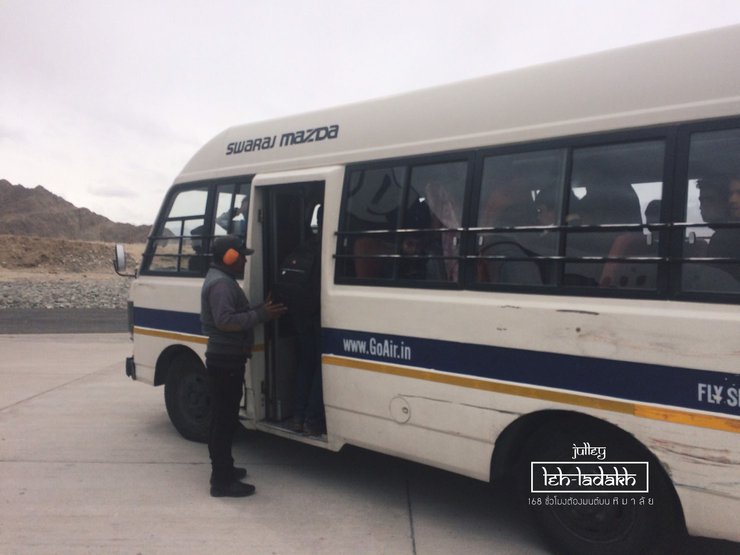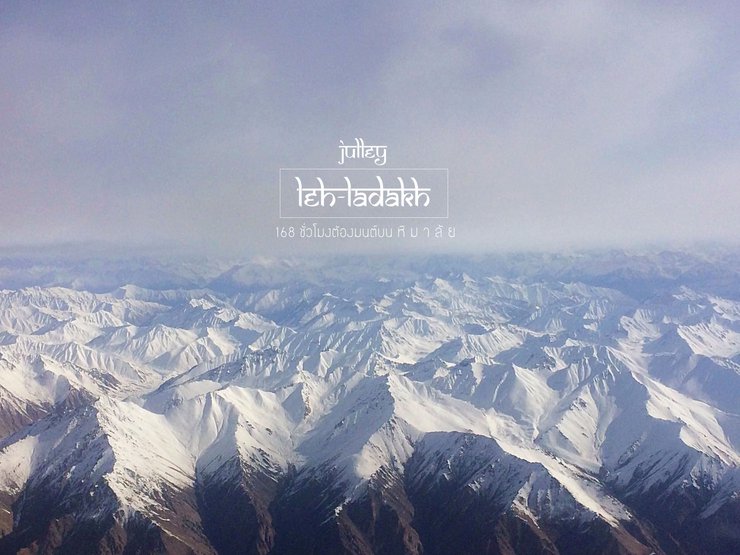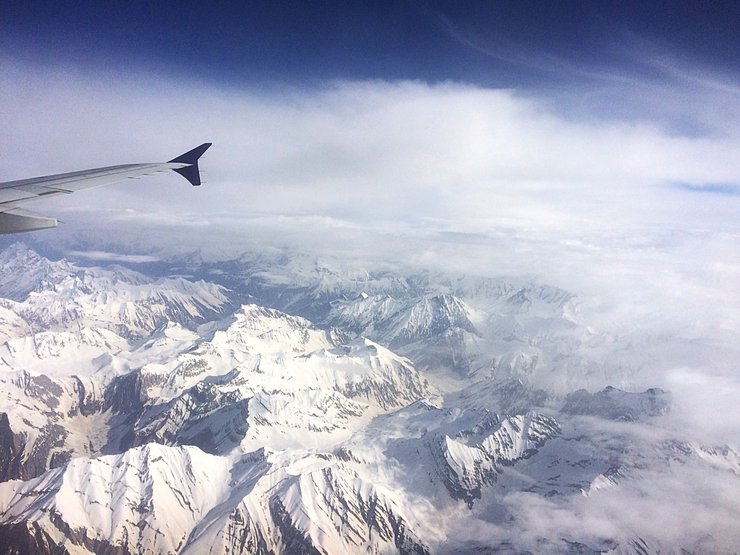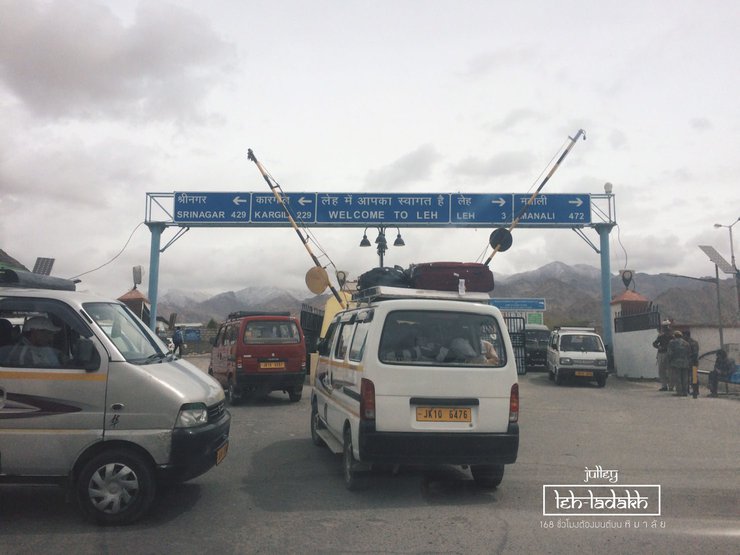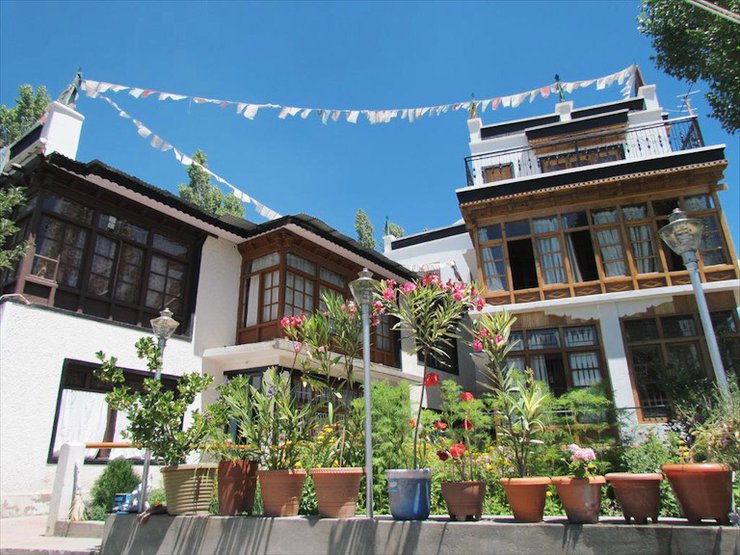"Juley" or pronounced as "Jule" in Thai.
_____________________________________
The first Ladakhi word we heard after setting foot in Leh. The taxi uncle from the airport taught us this word when he dropped us off at the guesthouse. It can be used for greetings, goodbyes, thank yous, and anything else you can't think of. Haha. This simple word was easy to say in the first few days, but it became difficult and reluctant to say on our last day in this land known as "Little Tibet".
_____________________________________
Inspired by the article "9 Reasons Why You Should See Leh Ladakh with Your Own Eyes Before You Die" by P'Pian the Walking Backpacker on Pantip.com and the View Finder show by Khun Phuri last year, I couldn't resist the urge to visit Leh Ladakh myself. With my friends' easygoing nature, we agreed to embark on this adventure to the exotic land of Ladakh within 5 minutes, much to the surprise of the person who invited us. The three of us embarked on our first journey to the land of the guests from April 29th to May 7th. We had no idea what season it was, how cold it would be, what the people would be like, or whether the food would be edible. We just knew there was no turning back. Now, more than a month later, I still think about it. I finally understand the saying, "You have to see it with your own eyes and experience it with your own heart." I can assure you that you will fall in love with Ladakh just like we did.
Please follow and support me. I'm not very good at reviewing, and the pictures may not be beautiful, but I hope everyone will like it.
And please support our small page https://web.facebook.com/Everywherewewander/ Feel free to visit and chat with us.
Okay! I've rambled on enough for someone who loves to talk. Let's get started, shall we? 55
Prepare before traveling
1. Where in the world is Leh Ladakh?

The capital city of Ladakh, "Leh," is commonly known as Leh Ladakh. It is our arrival point after a flight and is located in the state of Jammu and Kashmir. This state comprises three regions: Ladakh, Kashmir (with Srinagar as its main city), and Jammu. Situated in the northernmost part of India, Ladakh stands out for its distinct lack of "Indianness."
A little spoiler ahead, hehe.
2. Travel and Visa Information

- There are no direct flights from Thailand to Leh. You must first fly from Thailand to New Delhi, and then connect to a flight to Leh.
- From New Delhi to Leh, you can choose to go by train or bus, via the Leh-Manali route. This route is said to be very beautiful, but it takes several days.
Airline
1) We opted to fly with Thai Airways to New Delhi (International Terminal) and then took a connecting flight from New Delhi to Leh with Go Air, an Indian airline.
- A disadvantage is that you need to take a shuttle bus to the Domestic Terminal, which is quite far away. You should allow ample time for your connecting flight.
- We have ample time to reach Delhi by noon, take a quick stroll around the city, and then return to wait for our flight to Leh in the early hours of the next morning.
2) For convenience, Jet Airways of India is recommended, which allows for direct transfers from the international terminal.
3) Airlines from Thailand to India: Thai Airways, Jet Airways, Air India, Spice Jet
Airlines from Delhi to Leh: Jet Airways, Go Air, Vistara (departs from International Terminal), and Spice Jet.
- Primarily, Jet Airways and Go Air.
- Most flights to Leh are only available early in the morning.
Ticket price
- The price is around 15,000-20,000 baht. We have seen a Jet Airways promotion for around 13xxx baht.
- Book your tickets early. Flights from Bangkok to Delhi are generally available, but flights from Delhi to Leh can be expensive.
Visa matters
Entering India requires a visa.
We have already written about this topic in this thread https://pantip.com/topic/36523887. We hope it will be helpful.
3. How should I prepare my body?

Located at an altitude of 3,500 meters above sea level in the frigid Himalayas, Leh presents a challenge for lowlanders accustomed to sea-level oxygen levels. The thin air can lead to altitude sickness (AMS), characterized by fatigue, shortness of breath, headaches, nausea, and even fever and chills. AMS can affect anyone, regardless of fitness level. To prevent AMS and ensure an enjoyable Ladakh experience, it is advisable to bring Diamox (Acetazolamide).
1) It is recommended to eat 24 hours before arriving in Leh.
2) Remember to check the dosage of the medication.
- If the tablet size is 125 mg, take 1 tablet every 12 hours.
- If the medication is 250 mg, take half a tablet.
If you are unsure, please consult a pharmacist.
4. When is the best time to visit?
Situated at a high altitude, Ladakh experiences cold weather throughout the year. Even during the summer months, the temperature remains pleasantly cool. However, during the winter, temperatures can plummet to a bone-chilling -20 degrees Celsius.
Winter (October-March): The weather is extremely cold, so cold that you might think you'll freeze to death. However, Ladakh Lucky told me that the Chadar Trek, a trek on the frozen Zanskar River, is worth it. I definitely need to go back!
Spring season: late April-May when we visited, the weather was still below zero, and there were not many tourists.
Hot season: June-September is the peak tourist season, but the weather is pleasant and ideal for sightseeing.
The sentence is already in English and does not require translation.
5. Others
- Prepare warm clothes, windbreakers, gloves, socks, anything that will keep your body warm.
- The sun is very strong there, Gemini. So strong that even people who don't like to wear glasses, like me, have to put them on.
- The food there can be a bit difficult to eat (but for us, we eat everything 555). It has the smell of spices and curry powder. Those who have difficulty eating should prepare their own provisions, such as shredded pork, dried pork, chili paste, and instant noodles.
- To convert Indian Rupees to Thai Baht, simply divide by two. For example, 100 Rupees is approximately 50 Baht.
- Remember to bring a copy of your passport to apply for an inner line permit. When visiting places outside Leh, you will need a permit to pass through. This is because most of Ladakh is a border area and a sensitive zone. You can contact a local tour company there to arrange it for 700 rupees.
- Inform your family, parents, and partner in advance and prepare to be temporarily disconnected from the outside world, as internet access may be unavailable.
No need to read a lot of information, don't look at too many pictures, prepare yourself, prepare your mind to be empty, and let's go!!!
Now, let's get real! Now it's time for the magic hour!
_____________________________________
:: This trip takes us a total of 9 days and 8 nights, including travel days. ::
Day 1: Bangkok - New Delhi
The flight from Thailand to New Delhi took only about four hours, and we arrived at noon! The Delhi sun was scorching, as if it would melt the asphalt.
We only visited a few places: Connaught Place for lunch, our first meal in India (we survived!), the Red Fort, and Chandni Chowk market. We were exhausted by the time we returned to the airport for dinner, so I won't go into detail about that.
- The constant sound of car horns means you've arrived in India! It's an unforgettable experience.

Day 2: New Delhi-Leh
-Flight from New Delhi to Leh-
The flight costs hundreds of dollars, but the view is worth billions.
Our flight was scheduled for 6:40 AM, but it has been raining since early morning. The sky is overcast, and the staff has announced a flight delay. We are slightly worried that we might not be able to see the Himalayas.


I promised myself that I wouldn't fall asleep on the plane, but since I had only slept fitfully at the airport the night before, I ended up taking a short nap. >< I have to thank my friend for nudging me awake to see the view.

The flight was only a little over an hour, but I couldn't take my eyes off the view outside the window until the plane landed. The view was breathtaking, with the Himalayas stretching as far as the eye could see. If you're flying this route, choose a window seat on the left side for the outbound flight and the right side for the return flight. Trust me, it's worth it.

The sky is not cooperating, but it's still beautiful in its own way.

Upon landing at Leh Airport, I was surrounded by 360 degrees of mountains. I wanted to take a picture, but the staff wouldn't let me. I managed to take a sneaky one when they weren't looking. The atmosphere was amazing, with a gray sky and falling snow. I started to worry that I wouldn't see anything on this trip. As I stepped off the plane, I felt a blast of cold air. I was shivering from the first moment, going from 40 degrees in New Delhi to below zero in just a T-shirt.

The airport here is a small building that you wouldn't even know is an airport if you weren't told. After picking up my luggage, I stood awkwardly outside the building, looking for a taxi to take me into Leh. It was freezing! The fare should be around 200-300 rupees. Although Indian drivers are known for inflating prices, you don't have to worry about being cheated in Leh. There is a standard taxi fare here, which you can ask for or check online.
Our first night in Leh, we stayed at the Ashoka Guesthouse. We chose it because it was affordable and the rooms looked decent. We booked it through Booking.com about two days before our arrival, as it was a long holiday weekend and many Thai tourists were visiting. Our friend was worried that it would be difficult to find accommodation otherwise. We planned to find accommodation for the remaining nights once we arrived.
The price is 200-300 baht per person per night. Hot water is available, but there is no heater or breakfast.
Image source: Google. I forgot to take a picture at that time.

However, we believe that you can simply walk in and choose your accommodation during this period. This is because the tourist season is not yet at its peak in April-May, and there is no need to book in advance. Additionally, Leh has a wide range of guesthouses to choose from, catering to different budgets and preferences.
Upon arriving at the accommodation, we threw our belongings in the room and freshened up. Bundled up like bears to combat the chilly weather, it was time to hunt for food! After grabbing a bite at 3 am at the Delhi airport, the first order of business upon reaching Leh was to rest and allow our bodies to adjust to the 3,500-meter altitude. Staying hydrated and minimizing exertion were crucial to avoid AMS, but hunger pangs proved relentless, propelling us out the door in search of sustenance.
Stepping out of the accommodation, the midday atmosphere was still shrouded in mist. At that moment, I started to worry again if I would be able to see the beautiful Leh Ladakh as seen in the reviews during these 7-8 days. Tears were about to fall. It was cold, and my hands were starting to feel numb (I was starting to get frustrated). 555
Following the guesthouse's recommendation, we embarked on a culinary adventure towards the bustling Main Bazaar, Leh's central market. Our journey commenced with a straightforward walk from the guesthouse.
: On the way to Main Bazaar :

: Oh, Sakura is here too. So, are you in Japan or India? Leh also has its own kawaii charm. :

At that time, we agreed that we would go to any restaurant that was open. We went to the first restaurant, it was closed! We walked a little further, it was closed! Until we found this restaurant "LAMAYURU". It is a restaurant that we recommend you to try if you come to Leh. We guarantee you will not be disappointed!!!
: The shop is located on Fort Road. If you are heading towards the market, it will be on your left-hand side.

Upon opening the menu, we were completely clueless about the dishes. We ended up pointing and asking about each item, haha! Luckily, the restaurant wasn't busy at the time. Our friendly server, Lucky, kindly recommended some local dishes while gently cautioning us that we were ordering too much food for four people. She assured us that we had plenty of time to eat more on other days.
Oops! 555 So cute, GG.
: The first local dish to recommend is 'Momo', similar to steamed dumplings.

: The next menu item is Chicken Biryani, an Indian-style chicken and rice dish served with yogurt.

: For a warm drink to beat the cold, try 'Chai' or 'Jai', or Milk Tea. Enjoy it three times a day before meals. It's delicious!

And many more menus to follow, ordered with real hunger, with good intentions! Don't order too much, because the amount of food in the restaurant in Leh is huge. The chicken biryani is full of plates, even though we eat a lot, we can only eat half. No matter how much we eat, it doesn't decrease. I really admire it, haha. When I called for the bill, the same Ladakh guy who took the order and served the food saw the food left over and seemed a little disappointed. He also asked if it wasn't delicious? It's delicious, but I can't finish it. I'm sorry, haha.
This meal not only filled my stomach to the point of bursting, but also taught me a new Ladakhi word.
"SHIMPO" means delicious.
After finishing our lunch, we didn't go back to sleep. Instead, we had to find a tour agency. Due to our busy schedules before the trip, we barely had time to research or plan our itinerary. We followed the same principle as choosing a restaurant: go with the first one we see. About 20 meters from the restaurant, we found 'Dream Land Trek and Tour' on the right-hand side. This is where we entrusted our entire trip to.

Javeed greeted us with his usual "julley" and inquired about our plans, asking if there were any other places we wanted to visit.
The short answer is that I have no idea. I only know that I have 7 days and 6 nights in Ladakh. I want to visit Pangong Lake, Khardung La Pass, and Tso Moriri, as suggested by a friend. We argued back and forth for a while, and this is what we came up with.
Day 1: Explore Leh in the afternoon, starting with Leh Palace, Namgyal Tsemo Monastery, Shanti Stupa, and concluding at the Main Bazaar.
Day 2: Lamayuru Excursion
Embark on a day trip to Lamayuru, a captivating village nestled amidst the majestic Himalayas. Witness the enigmatic Magnetic Hill, where vehicles defy gravity and seemingly roll uphill. Explore the confluence of the Indus and Zanskar rivers, marveling at the confluence of turquoise and emerald waters. Delve into the ancient Alchi Monastery, a treasure trove of Buddhist art and architecture. Immerse yourself in the lunar-like landscapes of Moonland, a surreal expanse of eroded rock formations. Conclude your journey in Lamayuru, a village steeped in history and spirituality.
- We chose to go to Lamayuru because we had to wait for a permit to visit various places outside Leh city on the remaining days.
Day 3: Leh to Nubra Valley via Khardung La Pass
Day 4: Nubra Valley to Pangong Lake via the Shyok route
Day 5: Journey from Pangong Lake to Leh via Chang La Pass
Day 6: Journey from Leh to Tso Moriri
Day 7: Return to Leh from Tso Moriri
Day 8: Drop off at the airport.
Javeed will arrange a driver to take us on a tour of Ladakh, obtain the necessary permits for travel outside Leh, and offer a price that includes accommodation for the remaining nights in both Leh and outside Leh. After calculating the costs, we found the price to be reasonable, so we decided to accept the deal to avoid the hassle of finding everything ourselves.
**Contacting the driver directly will result in lower prices. You can also arrange your own accommodation and meals. Here is the contact information for the driver who took us on our trip. He also serves as a guide and speaks English fluently. He is a safe driver and very friendly. His name is Jimmy. You can try sending him an email at [email protected]. If you are unable to contact him, you can send us a private message. (No vested interest, haha)**
The remaining half of the afternoon was spent exploring Leh, a warm-up at an altitude of 3,500 meters, in this small taxi cab with this Ladakhi driver (whose name I never asked).

A small taxi cab slowly took us on a winding climb up to the 'LEH PALACE', or Leh Palace, which is situated on a hilltop overlooking the city of Leh. This was our first stop!


: Leh Palace, also known as Lachen Palkhar, is a former royal palace located in Leh, Ladakh, India.
An ancient palace that served as the residence of the Ladakh royal family in the past.
Remember to show your Thai passport to the staff. The entrance fee is only 15 rupees, which is equivalent to 7.5 baht, for a panoramic view of Leh city.



: Leh from a bird's-eye view :

The bustling Main Bazaar, or Leh's main market, is located below, adorned with colorful prayer flags.

Within the palace, some rooms display photographs of important landmarks in Ladakh. The rest were too dark to photograph, so I focused on capturing views of Leh city instead.


The mountains appear as if someone has pasted a painting onto the landscape. Everywhere you look, the mountains are in full HD, with snow falling on the peaks, creating a dramatic atmosphere.

The rooftop of Leh Palace offers unobstructed 360-degree views of Leh city. Behind the palace, at a higher elevation, stands Namgyal Tsemo Monastery.
During our two-day stay in Leh, we were frequently approached by Indian tourists requesting to take photos with us. This began in New Delhi, where a couple took turns photographing with each of us. Later, at Leh Palace, a group of Indian tourists asked us to join them in a photo. Initially, we thought they wanted us to take the photo for them, but they invited us to be in the picture with them. We were surprised and a little awkward, unsure if they were simply curious or found us unusual.

The scene shifts to the other side of the city. Perhaps because it is still early spring, there is no greenery to be seen in Leh. The light brown of the trees contrasts beautifully with the white houses.
Slender, tall, brown trees like this are found all over the city.

The other side offers a view of snow-capped mountains in the distance, which I believe to be Khardung La Pass. The sight is reminiscent of powdered sugar sprinkled on chocolate, making it look quite tempting.

Having fully enjoyed the view from here (almost completely ignoring the palace), it's time to move on...
Located high above Leh Palace, Namgyal Tsemo Monastery can be reached by foot, but the steep climb may deter some visitors. Alternatively, a short car ride provides a more convenient option, especially for those who may find the ascent to the rooftop challenging.

: Namgyal Tsemo Monastery :
Another important landmark in Leh city. We regretted not going inside because seeing the way up, we just wanted to walk smoothly to another way to take pictures of the view.

: I came across this adorable dog, peacefully soaking up the evening atmosphere. What a sight to behold! I didn't want to disturb its tranquility.

"Mantra Flags" are colorful flags commonly seen throughout Ladakh. They are traditionally tied in high places such as mountaintops, streams, temples, and sacred structures for good fortune. Ladakhi people believe that when the wind blows, the mantras inscribed on the flags are carried away by the wind, acting as a form of prayer.

We believe that at that time we ourselves also began to be 'enchanted' by the spell of Leh, the highest city in the world. What a beautiful city!


Before leaving, I took a solo photo with the magic flag, hoping for good luck and favorable weather throughout the trip.
A wider shot would reveal a fluttering line of magical flags, like a forest of enchantment. This is a must-visit spot for photographers.

Next, we head to our third check-in point of the day, "Shanti Stupa".
Upon arrival at Shanti Stupa, the first thing that catches our attention is not the stupa itself or the view, but rather the 'restrooms'.
Seeking a scenic view for a bowel movement? The olfactory experience remains to be discovered, as I have yet to personally embark on such an endeavor.
Upon arrival at Shanti Stupa, the first thing that catches our attention is not the stupa itself or the view, but rather the 'restrooms'.
Seeking a scenic view for a bathroom break? Wondering about the aroma? Come experience it for yourself! We haven't tried it yet, haha.

Transitioning to a more informative mode, the "Shanti Stupa," also known as the Peace Pagoda, is a prominent landmark in Leh. This whitewashed stupa, constructed by the Japanese, serves as a symbol of global peace.

From Shanti Stupa, you can see Namgyal Tsemo, which we visited earlier, and have a wider view of Leh city.

The soft, golden light of the setting sun creates a picturesque scene, perfect for capturing stunning photographs and enjoying the breathtaking views.

While walking around the pagoda, we were joined by a new member. Let's call this picture "My life is full of dogs."

The white dog likely knew that there was food inside the bag our friend was carrying, specifically the leftover Momo from lunch. It originally followed us closely, but in the end, we had to give in and let it eat everything.

After taking in the breathtaking views from three different angles, it's time to head to our final check-in point for the day...
: Main Bazaar, the main market of Leh city. :

The Main Bazaar is similar to a walking street or Chatuchak market in Thailand. It offers a variety of local products, including Pashmina wool scarves, warm clothing, food, dried fruits, sweets, restaurants, camera and photo printing shops, Himalaya cream (their lip balm is really good!), and much more. However, we arrived in the evening when it was not as crowded. If you come in the morning, you will see Ladakhi locals selling fresh produce on both sides of the street.

Strolling through the city, taking in the sights, sounds, and people, offers a unique kind of pleasure before the Leh sky darkens and the biting cold creeps in.
The first day in this enchanting city flew by, but we were still full from lunch, so we ended the day by boiling 'Maggi', an Indian instant noodle in a yellow packet, and sipping it hot (if you can't eat other foods, I recommend buying Maggi at a grocery store and taking it with you. I guarantee you'll survive). Then we went to bed early because Javeed was sending someone to pick us up for a tour at 9 am the next morning. The thing we were most afraid of was: would we survive the cold tonight?! 5555 They said the temperature would drop below 0 degrees. When I touched the blanket and the bed, I could feel the extreme coldness. And even though the guesthouse had hot water for showering, we couldn't bring ourselves to do it. Haha.

And to top it all off, we had booked two bedrooms for four people, but ended up crammed together like sardines in one room! One bed! With five layers of blankets, no less! Boom! Cramps, anyone? I slept in the same position all night because I couldn't move, thanks to the weight of the blankets. Oh, and it was freezing cold! >_< Who said it wouldn't be too cold this time of year? (Me, apparently.)
Day 2 in Ladakh
: L A M A Y U R U - A Day Trip :
Magnetic Hill - Confluence of the Indus and Zanskar Rivers - Alchi Monastery - Lamayuru Moonland
The first night in Leh was freezing, but I managed to sleep well, probably due to exhaustion. The sky here brightens very quickly. I checked my watch, and it was just past 5:00 AM, but it was already bright. (I secretly congratulated myself for waking up early. Hehe. I forgot that the time here is an hour and a half behind Thailand!) I woke up feeling happy today. Oh, the sky is so blue! There are almost no clouds. The altitude sickness from yesterday is gone!

Today, we will visit 'Lamayuru'.
The Journey Begins: A Punctual Start and a Hilarious Mishap
Our driver for the day arrived promptly at 9:00 AM, ready to embark on our Ladakhi adventure. We, however, were running a bit behind schedule, already exhibiting our penchant for tardiness on the first day. To add to the amusement, our pre-departure moments were marked by an embarrassing incident. Still slightly under the influence of the previous night's revelry, we engaged in a comical dispute with the guesthouse owners over the room charges, confusing Thai baht with Indian rupees. We barely managed to salvage our dignity before bidding farewell to the friendly Ladakhi couple. They wished us well for the rest of our Ladakhi escapade and bid us adieu with a warm "Juley," as we were scheduled to move to a different accommodation that evening.

"Following the Thai proverb 'An army marches on its stomach,' we asked our driver to stop for breakfast along the way."
Today, we're trying out 'Gesmo,' the green restaurant next to Lamayuru, where we ate yesterday. It's another highly recommended spot.

The food menu is similar to Lamayuru, but this place also offers a variety of bakery items.

After a long delay, we finally set off on our journey at around 9 am. We passed through the airport and headed out of the city on the Leh-Srinagar highway.

The scenery outside Leh is breathtaking, prompting frequent photo stops.
The driver informed us that the river we were witnessing was the Indus River. The tall, slender trees that were prevalent throughout Leh were identified as poplar trees. Locals often utilize these trees to construct window frames for their homes.

On the way to Lamayuru, there are many places to stop and take pictures.
Approximately 30 kilometers from Leh city, you will encounter the intriguing "Magnetic Hill," also known as the gravity-defying hill.


Second point: The confluence of the Indus and Zanskar rivers, where the two colors of the water meet. When we were there, we could barely distinguish the difference in color.
However, I secretly prefer the azure hue of the Indus River that I glimpsed along the way.

Ah! And this is "Jimmy" (whose contact information we provided above), who will be our guide and companion throughout our entire 6-day trip.
He is both a driver, a guide, and an answerer to our curious questions. He is like a daddy who takes care of us all the time. Let's just say he is everything to me, even though I have never been anything to him. Wow! 5555

: Travel a little further and you will reach 'Alchi Monastery', the oldest monastery in Ladakh. :

Along the way, we saw pink cherry blossoms contrasting with the dry brown mountains. At first, we thought it was cherry blossoms, but Mr. Jimmy told us it was an apricot tree. We were wrong for so long! If we came during the spring, it would bloom with cute pink flowers, but if we came during the summer, the apricot would bear fruit for us to taste.

: Moon Land: The Land of the Moon :
The sheer magnificence of nature is truly awe-inspiring. It is difficult to fathom that such a place exists on Earth. The experience is akin to walking on the moon.

: And today's destination is "Lamayuru Monastery".

Perched atop a lofty hill, Lamayuru Monastery commands breathtaking views of the Moon Land and the Lamayuru village below. As the largest and oldest monastery in Ladakh, it stands as a testament to the region's rich history and spiritual heritage.


While temples in Thailand typically have bells to be struck, in Ladakh, the practice involves rotating a Dharma wheel. The underlying purpose of both actions appears to be similar.

We stayed there for a while until 4 pm, then we had to travel back to Leh. On the way back, Jimmy took us to the two-colored river again. This is another spot where you can sit and watch the sun slowly set behind the mountains of Sangskar. It would be very romantic if the wind wasn't so strong and cold!

Today's journey was a sleepless one, but the views along the way were captivating. One of the things I particularly enjoyed was the presence of thought-provoking signs along the roads of Ladakh, reminding drivers to exercise caution. An example of such a sign is shown in the picture.
Encountered a fellow biker, a Westerner who braved the cold wind on his motorcycle. Truly admirable.

After spending two full days in Leh, a captivating city in the Himalayas, it becomes evident that the Ladakhi people, or Ladakhis, do not share the typical Indian appearance. For instance, our guide Jimmy's features resemble those of Tibetans more closely. Their food, language (Ladakhi), religion, and culture, among other aspects, have been heavily influenced by Tibet. This is why Ladakh has earned the nickname "Little Tibet."
Jimmy informed us that nearly 80% of Ladakhis practice Vajrayana Buddhism, which explains the prevalence of stupas and monasteries throughout Ladakh. They hold the Dalai Lama in high regard. From our interactions with Ladakhi people at guesthouses, restaurants, markets, tour agencies, and even taxi drivers, we found them to be incredibly friendly and welcoming. We were greeted with "Julley" wherever we went. Their kind and patient nature was a stark contrast to the honking and chaos experienced in other Indian cities. Ladakh's unique character led us to consider it a "country within a country," distinct from the rest of India.
This concludes the post with this final image. This was just a warm-up, having just completed '48 Hours Under the Spell of the Himalayas'. In the next episode, we will take you on a journey through the highlights of Ladakh for the remaining 120 hours, including camel riding in the desert, the highest road in the world, the saltiest lake in the world, and more. Don't miss it! Please follow us and say hello at https://www.facebook.com/Everywherewewander/

ไปทั่วไปทีป
Tuesday, October 8, 2024 11:20 AM

![cover Julley 'LEH,LADAKH' 168 Hours of Enchantment in the Himalayas [PART 1]](https://asset.readme.me/files/52464/cover.jpg?v=d09fa956)
![cover Julley 'LEH,LADAKH' 168 Hours of Enchantment in the Himalayas [PART 1]](https://asset.readme.me/files/52464/thumb.cover.jpg?v=d09fa956)

